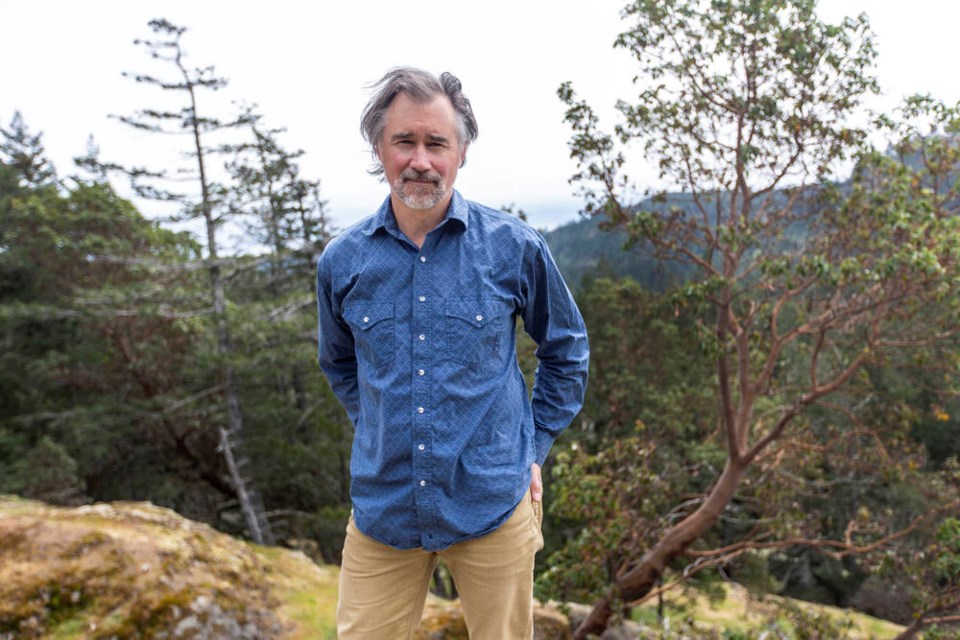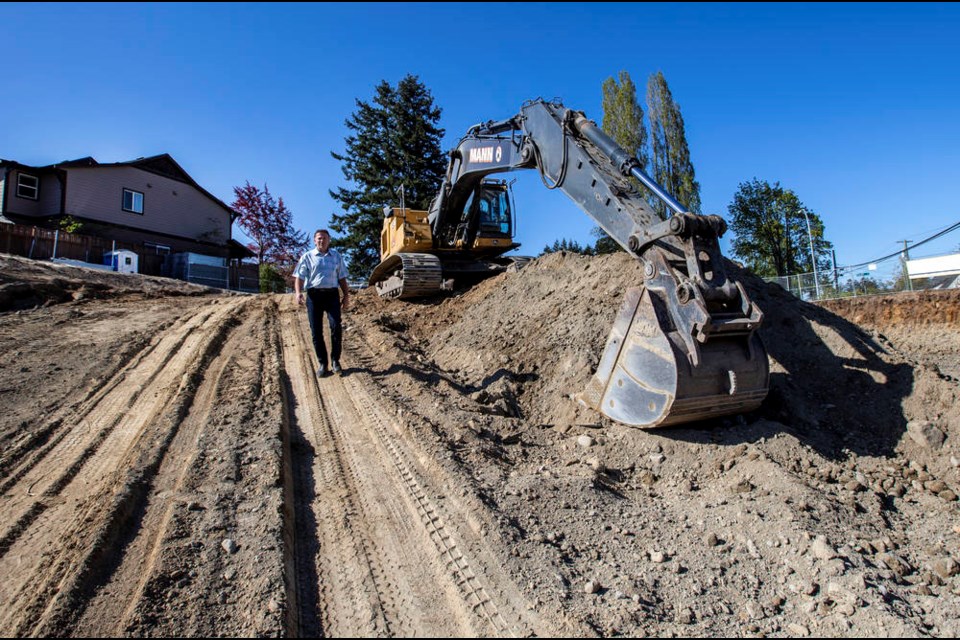As developers race to build more housing for Greater Victoria’s growing population, urban residents and politicians often focus on the size of the projects, the number of parking spaces and whether the design fits with the neighbourhood.
One issue that rarely gets discussed is where all the dirt goes every time someone digs a new basement or an underground parking lot.
It’s a question that’s of increasing concern to both the construction industry and residents of the rural areas where much of the uncontaminated soil or “clean fill” gets dumped on private properties — sometimes in such massive amounts that it alters the landscape.
People who moved to Metchosin or Shawnigan Lake or the Juan de Fuca Electoral Area for a more bucolic existence now find themselves dealing with big-city problems like dust, traffic noise and window-rattling vibrations as hundreds of trucks rumble past, loaded with dirt from construction sites in Victoria, Colwood or Langford.
Rural residents worry that all that extra soil will spill onto neighbouring properties, pollute aquifers or clog creeks and streams with silt.
In some cases, residents are pressing councils to adopt tougher soil-dumping bylaws and crack down on property owners who skirt the rules by taking dirt without a permit or accepting prohibited materials.
“It’s the downside to the building booms that we’re seeing,” said sa���ʴ�ý Green Party Leader Sonia Furstenau, who represents the Cowichan Valley and Shawnigan Lake, where much of the fill gets deposited.
The construction industry, meanwhile, says the soil has to go somewhere, that many land owners require clean fill to level their properties or prepare sites for development, and that strict rules are in place to protect the environment.
Industry officials warn that if councils keep passing tougher bylaws and closing dump sites, companies will have to haul more clean soil out to sea or farther up the Island, which will burn fossil fuels, raise housing prices and slow development.
“The construction industry is very responsible,” said Monty Fitz, general manager of Don Mann Excavating Ltd. “We want to abide by all the regulations. We just feel that nobody really wants to help us solve this. They just want to push it to another community.
“So the Greater Victoria area pushed it to the [Cowichan Valley Regional District]. Well, the CVRD now comes along and says: ‘Well, you know what? We don’t want it either, let’s push it to the next district.’ And that is the reality of fill.”
But while the battles have been going on for years, construction officials say the situation is fast reaching a crisis point as costs skyrocket and threaten to undermine efforts to build more affordable housing. The situation has been exacerbated, they say, by the closure of several large dump sites in the CVRD that reached the limit of fill they were allowed to receive under permit.
“We’re driving development on one hand and on the other hand we’re constrained by where do we put excavated material?” said Rory Kulmala, chief executive officer of the Vancouver Island Construction Association. “There’s not a lot of places anymore. We have a high demand, yet no place for it.”
That’s why some industry insiders, rural residents and politicians want the provincial government to get more involved and help resolve the impasse.
“Some kind of provincial overview would be a real benefit,” said David Munday, president of the Shawnigan Basin Society, which is concerned about the impacts of soil dumping in the Shawnigan Lake watershed.
“All of these things are being developed in a vacuum, right? Metchosin’s looking at their situation. We’re looking at our situation. CRD has a different view.
“It would be nice to have some co-ordination.”
Furstenau agrees, noting that soil dumping touches on a number of ministries — environment, agriculture, transportation, mining — that have more enforcement tools than municipal councils.
“The province needs to recognize that this problem isn’t going to go away,” she said. “There needs to be really clear parameters about how this fill and how this waste is dealt with.
“They need to be providing the framework, and then the enforcement and compliance tools that are necessary to ensure that it’s not the Wild West, which is essentially what it is for a lot of these rural areas.”

One suggestion pitched by some in the construction industry is that every regional district or municipality should have to look after its own soil, so that one area isn’t benefiting from new development, while their neighbours get all the dirt.
“I think that right now we’re in a bit of a transition phase where nobody’s dealing with it,” Fitz said. “Nobody is trying to come up with constructive ideas as to where this dirt goes.”
sa���ʴ�ý’s Environment Ministry said in a statement that it takes concerns about the movement and disposal of both contaminated and uncontaminated materials seriously, which is why it’s working on changes that will streamline the approval process, add transparency and improve compliance.
At present, the province regulates the movement of contaminated soil under the Environment Management Act and the Contaminated Sites Regulation. Municipal governments have to be notified four business days in advance of contaminated soil being relocated, but there is no requirement to notify Indigenous Nations and there are no notification requirements for the relocation of uncontaminated soil.
The new rules will require those moving uncontaminated soils to first notify the ministry, municipality, or Indigenous Nation through an online platform, the ministry said in a statement.
“This improvement will mean people who have concerns will be able to access information as it is posted and register their concerns with the appropriate authority,” the ministry said. “This will improve data about the volumes and quality of soils moving to, from and within communities in the province.”
As well, there will be a more rigorous permitting process for the relocation of contaminated soil that includes a 30-day consultation period, the ministry said.
Meanwhile, municipalities are scrambling to stay on top of the issue.
In the Cowichan Valley, the regional district adopted a soil deposit bylaw in 2019 to better regulate dumping, but the issue remains a sore point for many residents, officials say.
“I think what the public believed was once we had the soil bylaw, the trucks would stop rolling,” said Sierra Acton, who represents Shawnigan Lake on the CVRD board. “And they haven’t. They’ve probably come more furiously now because Victoria has less space to take it — or none. And they are just sending it up here.”
The regional district doesn’t have the power to prohibit dumping, she said. But residents want to see more environmental protections and they’re pointing to Metchosin’s soil deposit bylaw as a model.
The Association for the Protection of Rural Metchosin, however, has its own worries and wants to see the district impose stiff penalties against landowners who dump without a permit or accept materials that pose a risk to the environment.
“In cases where there has been environmental damage that cannot be undone, the district should look at prosecutions and going to court,” say Jay Shukin, association president.
“They should not be treating these cases lightly and allowing the owner to get off with … so-called ‘voluntary compliance,’ where you take steps that are outside of the fine. We are looking for much more aggressive action from the district.”
Otherwise, he said, there’s nothing to prevent bad actors from continuing to flout the rules and damage the rural landscape.
“Once you have one dump truck dump one load in that wetland, that wetland is altered forever. You can’t undo that.
“So people in Metchosin who are thinking about taking actions that they know will harm the local environment and impact their neighbours — they need to be made to think twice about doing that.”
Mayor John Ranns insists that the district is already taking those steps.
“Fundamentally, there’s a misconception that we don’t enforce bylaws,” he said.
The district contracts with the Capital Regional District to provide bylaw services and every complaint gets addressed, Ranns said.
“Our whole focus is compliance driven, rather than punitive, because the punitive is a very long process, expensive and oftentimes doesn’t end well for the municipality.”
But he said there have been cases where Metchosin has pursued court action, especially if there is damage to the environment. It’s just that in those instances, the district is precluded from discussing details of the case in public, he said.
In any event, Ranns insists that dumping isn’t as big an issue in the district as it used to be and that most times when people report truck movements, it turns out the property owner has the proper permits or the trucks are passing through the district.
In those cases, they could be headed to Juan de Fuca Electoral Area, where director Mike Hicks says managing soil dumping has become an “administrative nightmare” that consumes a lot of staff time. As a result, the area is in the process of updating its soil deposit bylaw to better manage the issue, recoup costs and minimize the impact on residents, he said.
“A lot of the fill is coming from Langford and Colwood, and I’m talking thousands of trucks; I’m not talking a couple of trucks,” Hicks said.
“We don’t want to be saying to our good neighbours: ‘You can’t bring your soil here,’ because they have to take it somewhere. But we’ve got to find a balance that it doesn’t cost the taxpayers out here any money or inconvenience to have it come.
“And that’s what we’re trying to figure out right now.”



